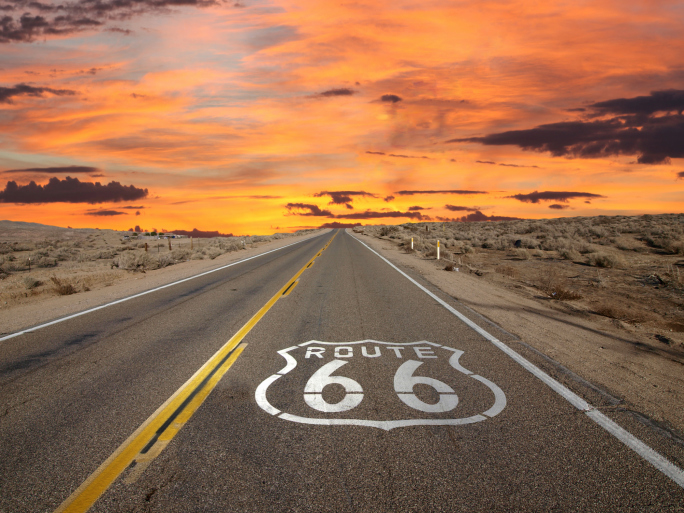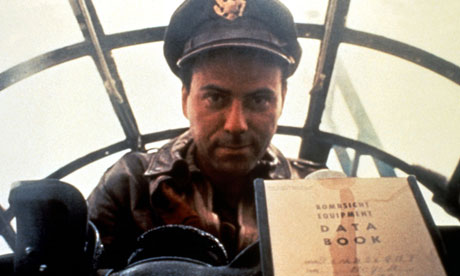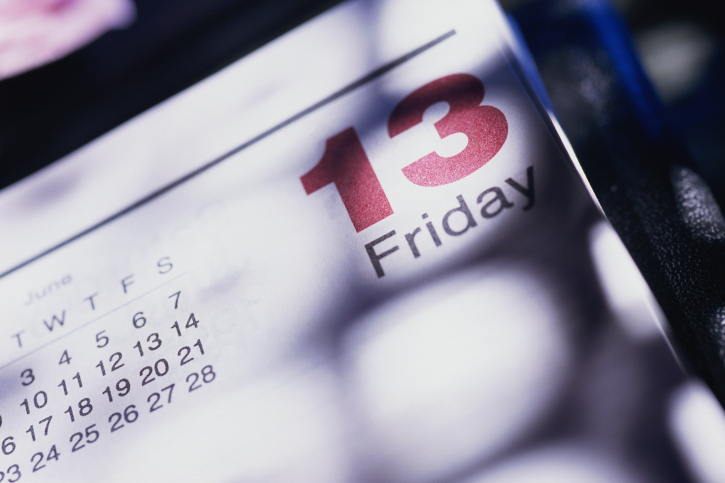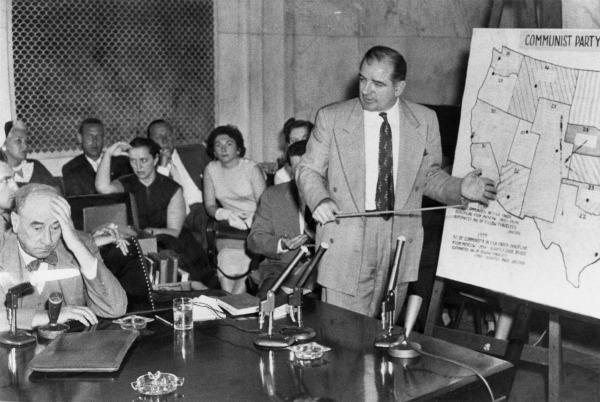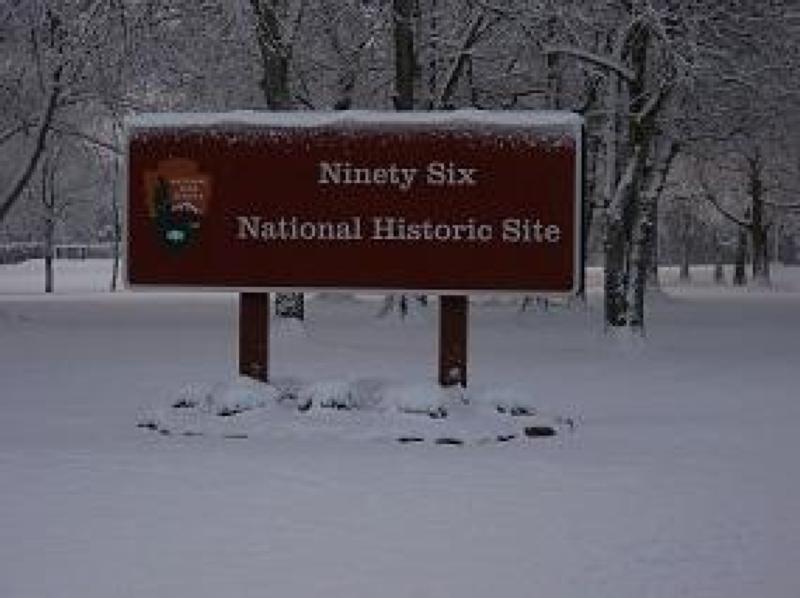10Route 66
It’s known as America’s Main Street. It’s the place where you can get your kicks. Running from Chicago to Los Angeles, Route 66 is an icon of Americana, whisking travelers across the nation’s heart. The road was decommissioned in 1985, but it still holds a mythical place in American culture. So why 66? Why not 12, or 384? Let’s go back to the beginning. In 1917, Wisconsin became the first state to prohibit the marking and naming of roads without the approval of the government. Previously, it was common for roads to be sponsored by motor clubs, private companies, and tourist boards, who would choose the route that best suited them—regardless of whether it was the best or quickest path for motorists. To replace this confusing system, Wisconsin’s State Highway Commission developed an efficient layout of numbered highways, an innovation that was quickly adopted across the country. In 1925, St. Louis was selected as the hub for four major highways traveling across the US. None of them was supposed to be numbered 66. Instead, Routes 40, 50, and 60 would run east/west, while Route 61 would travel north/south. But the plan hit a bump when Kentucky demanded the name Route 60 for the highway between Virginia Beach, Virginia and Springfield, Missouri (which ran right through Kentucky). The reason? Kentucky was the only state in the Missouri Valley without a road that ended in zero. Really, it was that petty. The original plan was for Route 60 to run between Chicago and Los Angeles, but Kentucky suggested that this could be renamed Route 62. The Bluegrass State got their way, but other state highway agencies weren’t enthusiastic about the Route 62 name—they wanted something more memorable. After noticing that the number was still available, Midwest agency members Cyrus Avery and B.H. Piepmeier sent a letter to the Bureau of Public Roads simply stating, “We prefer 66 to 62.” And that was that—the most famous road in the United States got its name after a silly fight over numbers ending with zero.
9Catch-22
“Catch-22” is a common phrase in English-speaking countries. It can defined as “a paradox in which the attempt to escape makes escape impossible.” The term comes from Joseph Heller’s classic novel of the same name, although its popularity as a phrase didn’t really take off until the 1970 movie came out. In the book and movie, the phrase refers to an Air Force ruling that only a crazy person would make an extremely dangerous bombing run without trying to get out of it. Any pilot who doesn’t try to get out of it is clearly deranged and therefore qualifies for immediate medical leave on the grounds of insanity. However, anyone who asks not to make the run must be sane (since trying to get out of danger is the sign of a rational mind) and therefore any pilot who requests medical leave for insanity cannot be granted it. Either way, every pilot has to make the run. Catch-22. But why Catch-22? Well, it’s mostly because another book took the original number. In 1955, the first chapter of what became Catch-22 appeared in a magazine under the title Catch-18. The full book hit stores in 1961, but by then there was another popular book with “18” in the title: Leon Uris’s Mila 18. The publishers thought that the reading public couldn’t handle two books with the same number in the title, so Catch-18 became Catch-22. But it’s not like 18 was just some random number Heller pulled out of the sky—it had a specific meaning that the new title lost. In Jewish culture, 18 is a highly significant number—the 18th letter in the Jewish alphabet is “chai” which means life (or living). Early drafts of Heller’s work had more of a Jewish emphasis. Heller suggested Catch-14 as an alternate title, but the catchier Catch-22 won out.
8Unlucky numbers
Different cultures consider different numbers to be bad luck. In English-speaking countries, it’s usually 13 which is held to be unlucky. This belief might go back as far as the Babylonian Code of Hammurabi, which skips a 13th law for unclear reasons. There are quite a few other indications that the number had negative connotations in the ancient world, including Judas being the 13th person to arrive at the Last Supper. The belief could have originated in ancient Sumeria, where 12 was considered the perfect number. In modern times, there are still many buildings in North America that don’t have a 13th floor due to the superstition. Every year, Friday the 13th sees about $800 million less in economic activity than you’d expect, as people tend to avoid the day for traveling or events like weddings. In 1907, Thomas Lawson had a hit bestseller with Friday the Thirteenth, in which a crazed stockbroker attempts to bring down the market, further cementing the day’s poor reputation. In Asia, it’s four which is considered bad luck. The number four in Chinese sounds remarkably similar to the word for death. Naturally, people don’t like to associate with anything that sounds like death. China went as far as discontinuing license plates with the number four in them. As American buildings skip 13, some Chinese buildings skip the fourth floor. Fans of the acclaimed Hong Kong police thriller Infernal Affairs (which was given a Hollywood remake as The Departed) may have noticed that the classic elevator scene skips the fourth floor.
7Sports Numbers
Look around any sporting event and you’ll see thousands of fans wearing their favorite players’ jersey. These days, the most popular players are practically synonymous with their number. The origin of numbered jerseys couldn’t be any simpler. In soccer, or football to most of the world, shirt numbers were introduced to match up with your position on the field. Goalies wore #1, and at the other end of the field the field strikers wore #9 and #10. The first substitute wore #12, and the next wore #14—naturally, few players wanted to wear unlucky 13. These days, numbers mostly no longer correspond to position, but some elements of the system remain, like the term “false nine ” for a striker who tends to drop deep into midfield instead of staying forward like a traditional #9. In baseball, the first team to wear numbers was the minor league team in Reading, Pennsylvania in 1907. Nine years later, the Cleveland Indians of the majors wore numbers for the first time (it only lasted a few weeks, but they brought them back later). As with soccer, baseball’s numbers coincided with positions—in this case in the usual batting order. So Babe Ruth’s famous #3 wasn’t his personal choice, it was because he batted third in the lineup. The Philadelphia Athletics were the last team to fully embrace numbers—they wouldn’t wear them for home games until 1937 .
6205 Communists
In one of the most infamous speeches in American political history, Senator Joseph McCarthy made a shocking allegation—there were communists working in the US government! The speech was headline-grabbing then, and it might be even more notorious now. McCarthy would eventually flame out after accusing the US Army of harboring communists and becoming the butt of ridicule for his over-the-top antics, which famously climaxed with him being chided, “Have you no sense of decency?” But his 1950 speech caused a sensation. The speech was given in the rather incongruous setting of the Women’s Republican Club of Wheeling, West Virginia. There’s some debate over how many communists McCarthy claimed were in the government, since he later announced that there were 57 card-carrying communists in the State Department, but most agree that the original number he gave was 205. So where did the flamboyant McCarthy pull that 205 number out of? Believe it or not the number did have some basis in reality. In 1946, the State Department’s screening committee identified 284 potential security risks—people with far left ties. Later in the year, 79 of them were let go, leaving 205. Congress had been informed of these findings in 1946, but it didn’t raise much of a stir. In 1950, immediately after the Alger Hiss trial, the first Soviet atomic bomb test, and the fall of China to communism, the mood was very different. So despite McCarthy’s questionable motives, he did have reason to believe that around 205 State Department employees could potentially be security risks. Naturally, McCarthy wildly exaggerated (he was so adamant that he had discovered 205 communists that it took the State Department weeks to realize he was alluding to their own investigation) but he didn’t just make the number up out of thin air either.
5Towns
Naming a town seems like a pretty straightforward thing. In America, they’re mainly named after people, local landmarks, or other towns. So if someone tells you it’s called New York because people just liked it better that way, you can correct them and say it was named for the eventual King James II of England, then known as the Duke of York and Albany. But what about towns named for numbers? One such town came to public attention via the national pastime. Bill Voiselle was a major league baseball pitcher during the 1940s. Today, he’s best remembered for his uniform number—at a time when everyone wore low numbers, Voisselle wore #96. His reasoning was pretty simple: he was from the town of Ninety Six, South Carolina. Ninety Six got its unusual name from a simple quirk of cartography. In 1730, surveyor George Hunter marked the area as being 96 miles from the Cherokee town of Keowee. The number made it onto the maps, and the name has stuck around ever since. The national building supply chain 84 Lumber got its name in a similar way—the company was founded in the town of Eighty Four, Pennsylvania. Like most number-based towns, there are all sorts of crazy stories about how Eighty Four came to be named, but the most likely story is actually quite simple. The small rural community wanted the name Smithville for their postal route. That name was already taken in eastern Pennsylvania, so postmaster H.F. Weir asked for the route to be named after the year the post office was built: 1884. A slightly abbreviated version ended up becoming the town’s official name.
4Heinz 57
The Heinz Company is known for making condiments—so many of them that the company famously adopted the advertising slogan “57 Varieties.” The company was founded in 1869 and has prospered ever since, although it took a bit of a tumble when John Kerry ran for President in 2004. Since Kerry was married to Teresa Heinz, the widow of company Heir John Heinz III, some Republicans claimed that purchasing Heinz products was “like giving to the Democrats.” Unsurprisingly, Heinz survived this backlash and continues to produce well over 57 products. So why is the number 57 associated with Heinz? It all started in 1896, when company founder Henry Heinz was on a train in New York City and passed a sign advertising 21 different styles of shoes. Heinz thought that was brilliant—it made the company seem complex and diversified and appealed to many different tastes in shoes. By that point, his company already had well over 60 products available, but Heinz decided 57 worked better. Some sources say he considered 57 his lucky number, others claim that his lucky number was five, and his wife’s was seven. Or maybe he just liked how it sounded. Regardless, the number 57 doesn’t actually refer to 57 specific varieties of anything—it’s just a catchy marketing device.
3Six Million Jews
There are some numbers that shouldn’t be questioned, yet Holocaust denial has been around since the 1950s, when the influential American priest Gerald L. K. Smith claimed that no Jews had been killed by the Nazis—they had all secretly emigrated to America instead. Former Iranian President Mahmoud Ahmadinejad is still telling anyone who can stand to hear him talk that the Holocaust is a myth, while others content themselves with claiming that the six million Jews estimated to have been killed is an exaggeration. But six million isn’t just a random guess—it’s well documented. The Nazis kept detailed records of their atrocities, including how many Jews were moved to concentration camps or killed by roving death squads. Adolf Eichmann, as responsible as anyone for planning the Holocaust, was confident that a bit over five million Jews had been killed. Historians have done extensive work to determine the exact number—including those who never even made it to Eichmann’s camps. For example, SS records confirm at least 7,000 died during the fighting of the 1943 Warsaw Ghetto Uprising. After meticulously scouring the records, the historian Lucy Dawidowicz put the total number killed at 5.93 million. Other historians have reached similar figures. The fact that these figures derive from German bureaucratic records should be enough to blow a hole in any Holocaust denier’s theories. There was a Holocaust, it was real, and the Nazis are the ones who said so.
2The 38th Parallel
The 38th parallel is a circle of latitude that served as the initial basis for the famous demilitarized zone (DMZ) between North and South Korea—the most heavily fortified border in the world. The DMZ traces its origins to World War II. As US forces landed in the south of Korea and the Soviet Red Army overran the Japanese forces in the north, there needed to be a line where the two armies could meet without overlapping (and possibly ending up fighting each other). The 38th parallel was chosen. But why? It turns out that the line had no real historical significance. Prior to the Allied invasion, Korea functioned as a whole pretty well. It was the Soviets and Americans who decided to split the nation. Dean Rusk, a member of General George Marshall’s staff (and a future Secretary of State), looked over a National Geographic map with Army Colonel Charles “Tic” Bonesteel. The pair were determined that Seoul should be in the American zone, but they couldn’t find a natural break north of the city. They eventually settled for the 38th parallel, around 56 kilometers (35 mi) north of Seoul. The Soviets agreed to the entirely arbitrary dividing line and the rest is (war-torn) history.
1Letterman’s Top 10 lists
Everyone loves lists. There are even websites based on the idea. But the idea behind a Top 10 list didn’t originate in the Internet age—magazines have been doing them for decades. But nothing helped popularize Top 10 lists as much as Late Night with David Letterman. In its early days, Letterman was known for being edgier than other talk shows—since it was on later in the evening, it had more leeway to get away with silly stunts. Writer Randy Cohen has often been given credit for the idea of doing a humorous Top 10 list, but Cohen himself says it was more of a team effort. Which is good, because it seems like everyone who worked for Letterman except Letterman himself thinks they came up with the idea as a spoof of other Top 10 lists. The direct inspiration was likely a Cosmopolitan list of the 10 sexiest men over 60. The first list, written by Kevin Curran, was the Top 10 Words That Almost Rhyme With “Peas.” But what about Listverse? Well, our very first list was published way back in 2007. And while Listverse didn’t always follow the 10-item format, it works well, as history has shown us. Jake wrote a trivia e-book filled with crazy stuff like the kind you just read in this list. You can follow him on Twitter for more useless facts.
